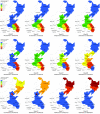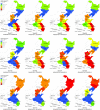Inferring the potential risks of H7N9 infection by spatiotemporally characterizing bird migration and poultry distribution in eastern China
- PMID: 23849083
- PMCID: PMC3710089
- DOI: 10.1186/2049-9957-2-8
Inferring the potential risks of H7N9 infection by spatiotemporally characterizing bird migration and poultry distribution in eastern China
Abstract
Background: In view of the rapid geographic spread and the increasing number of confirmed cases of novel influenza A(H7N9) virus infections in eastern China, we developed a diffusion model to spatiotemporally characterize the impacts of bird migration and poultry distribution on the geographic spread of H7N9 infection.
Methods: Three types of infection risks were estimated for 12 weeks, from February 4 to April 28, 2013, including (i) the risk caused by bird migration, (ii) the risk caused by poultry distribution, and (iii) the integrated risk caused by both bird migration and poultry distribution. To achieve this, we first developed a method for estimating the likelihood of bird migration based on available environmental and meteorological data. Then, we adopted a computational mobility model to estimate poultry distribution based on annual poultry production and consumption of each province/municipality. Finally, the spatiotemporal risk maps were created based on the integrated impacts of both bird migration and poultry distribution.
Results: In the study of risk estimation caused by bird migration, the likelihood matrix was estimated based on the 7-day temperature, from February 4 to April 28, 2013. It was found the estimated migrant birds mainly appear in the southeastern provinces of Zhejiang, Shanghai and Jiangsu during Weeks 1 to 4, and Week 6, followed by appearing in central eastern provinces of Shandong, Hebei, Beijing, and Tianjin during Weeks 7 to 9, and finally in northeastern provinces of Liaoning, Jilin, and Heilongjiang during Weeks 10 to 12.In the study of risk caused by poultry distribution, poultry distribution matrix was created to show the probability of poultry distribution. In spite of the fact that the majority of the initial infections were reported in Shanghai and Jiangsu, the relative risk of H7N9 infection estimated based on the poultry distribution model predicted that Jiangsu may have a slightly higher likelihood of H7N9 infection than those in Zhejiang and Shanghai, if we only take the probability of poultry distribution into consideration.In the study of integrated risk caused by both bird migration and poultry distribution, the higher risk in southeastern provinces occurred during the first 8 weeks, and that in central eastern provinces appeared during Weeks 8 to 12, and that in northeastern provinces since Week 12. Therefore, it is necessary to regulate the poultry markets as long as the poultry-to-poultry transmission is not so well understood.
Conclusion: With reference to the reported infection cases, the demonstrated risk mapping results will provide guidance in active surveillance and control of human H7N9 infections by taking intensive intervention in poultry markets.
Figures




References
-
- Rongbao G, Bin C, Yunwen H. Human infection with a novel Avian-Origin influenza A (H7N9) virus. New England J Med. 2013. [ http://www.nejm.org/doi/full/10.1056/NEJMoa1304459] - DOI - PubMed
-
- Forbes. H7N9 Bird Flu cases in China rise by five To 96; deaths increase to 18. News. [ http://www.forbes.com/sites/russellflannery/2013/04/20/h7n9-bird-flu-cas...]
-
- China Daily. H7N9 outbreak linked to waterfowl migration. News. [ http://usa.chinadaily.com.cn/china/2013-04/19/content_16421316.htm]
-
- South China MorningPost. H7N9 infected birds will migrate to Pearl River Delta, says microbiologist. News. [ http://www.scmp.com/news/hong-kong/article/1213236/h7n9-infected-birds-w...]
LinkOut - more resources
Full Text Sources
Other Literature Sources
Miscellaneous

